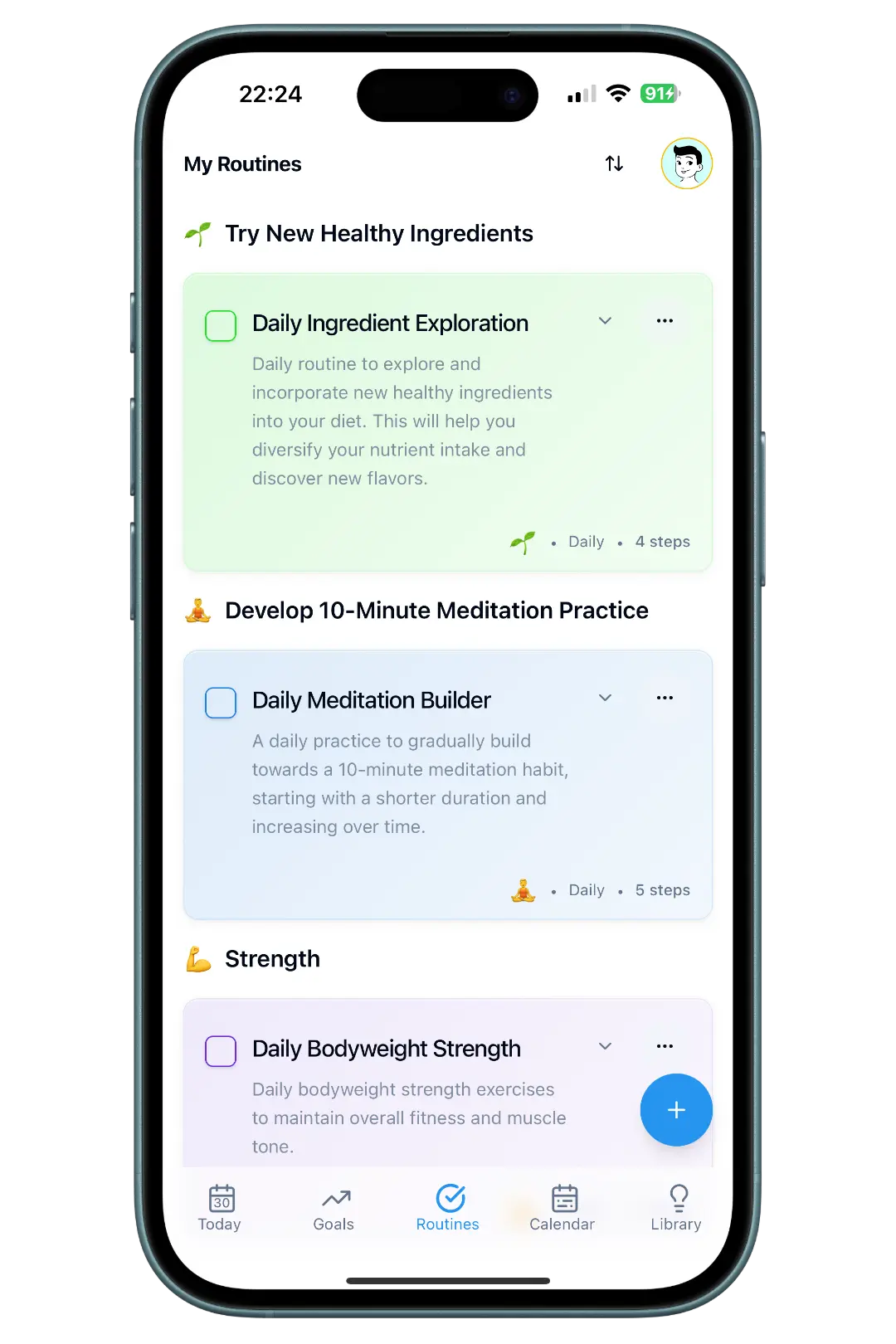
The Power of Planning: How Structure Improves Your Health Habits
February 11, 2025
"Failing to plan is planning to fail"—and nowhere is this more true than with health habits. Without a plan, you're at the mercy of daily circumstances, motivation levels, and competing priorities. But with the right planning structure, healthy choices become inevitable. Here's how strategic planning transforms good intentions into lasting health transformations.
The Planning Paradox in Health
Why Smart People Skip Health Planning
Common Planning Avoidance:
- "Planning feels rigid and constraining"
- "I prefer to be spontaneous with my health choices"
- "Planning takes too much time"
- "I tried planning before and it didn't work"
The Hidden Truth: People who resist planning actually have less freedom and more stress because they constantly face decision fatigue and unpredictable outcomes.
The Freedom of Structure
Well-planned health habits provide:
- Mental freedom: No daily decisions about what, when, or how
- Time freedom: Efficient routines that maximize results
- Emotional freedom: Confidence in your ability to maintain health
- Physical freedom: Energy and health to do what matters most
The Science Behind Health Planning
Cognitive Load Theory and Health Decisions
Your brain has limited decision-making capacity each day. Every health choice you make without a plan depletes this resource:
Unplanned Health Living:
- Constant micro-decisions about food, exercise, sleep
- Decision fatigue leads to poor choices later in the day
- Reactive rather than proactive health management
- Inconsistent results due to inconsistent inputs
Planned Health Living:
- Pre-decided healthy choices require minimal mental energy
- Preserved willpower for unexpected challenges
- Proactive health management
- Consistent results through consistent systems
Implementation Intentions Research
Studies show that people who create specific "if-then" plans are 2-3x more likely to follow through on health goals:
Vague Intention: "I will exercise more"
Implementation Intention: "If it's 7 AM on a weekday, then I will do a 20-minute workout in my living room"
The specificity removes decision-making from the moment of action.
The P.L.A.N.N.E.D. Health Framework
P - Prioritize Your Health Goals
Principle: Plan around your most important health outcomes, not every possible improvement.
Priority Setting Method:
- Identify impact areas: What health improvements would most enhance your life?
- Assess current state: Where are you now in each area?
- Calculate effort-to-impact ratio: Which changes give the biggest return on investment?
- Choose your top 3: Focus your planning on maximum-impact areas
Example Priority Framework:
- High Impact, Low Effort: Daily water intake, basic sleep hygiene
- High Impact, Medium Effort: Regular movement routine, meal planning
- High Impact, High Effort: Comprehensive fitness program, major dietary overhaul
Start with high impact, low effort items and build your planning skills before tackling more complex changes.
L - Layout Your Weekly Structure
Principle: Design your week to make healthy choices the default option.
Weekly Planning Template:
Sunday Planning Session (15 minutes):
- Review previous week's health wins and challenges
- Plan next week's movement schedule
- Decide on meal themes and prep needs
- Set intentions in ProgressMade
Daily Structure Planning:
- Morning routine: 2-3 health habits to start the day positively
- Midday check-in: Energy assessment and adjustment opportunity
- Evening routine: Recovery and preparation for tomorrow
- Weekend structure: Maintain routine while allowing flexibility
Meal Planning Structure:
- Breakfast: 3 go-to options that require minimal decision-making
- Lunch: Batch-prepared options or simple assembly meals
- Dinner: Weekly rotation of favorite healthy meals
- Snacks: Pre-portioned healthy options always available
A - Anticipate Obstacles
Principle: Plan for problems before they derail your health habits.
Common Obstacle Planning:
Time Obstacles:
- Busy morning plan: 5-minute movement + grab-and-go breakfast
- Long workday plan: Desk exercises + healthy meal delivery
- Travel plan: Bodyweight exercises + airport/hotel food strategies
- Weekend plan: Maintain structure while allowing spontaneity
Energy Obstacles:
- Low energy plan: Gentle movement + nourishing foods
- High stress plan: Stress-reduction practices + comfort foods that align with goals
- Sick day plan: Rest + hydration + minimal movement when possible
- Motivation dip plan: Minimum viable habits + accountability check-ins
Environmental Obstacles:
- Bad weather plan: Indoor movement alternatives
- Limited kitchen access plan: No-cook meal options
- Social event plan: How to enjoy while maintaining health goals
- Equipment failure plan: Backup exercise and meal options
N - Navigate with Daily Intentions
Principle: Start each day with clear health intentions that guide decisions.
Daily Intention Setting (2 minutes each morning):
- Check in with your body: How do you feel physically and emotionally?
- Review your planned health actions: What's on your schedule today?
- Set your daily health intention: What's your one health priority for today?
- Anticipate today's challenges: What might interfere and how will you adapt?
Daily Intention Examples:
- "Today I prioritize hydration because I felt sluggish yesterday"
- "Today I focus on stress management because of my big presentation"
- "Today I maintain my movement routine despite the busy schedule"
- "Today I practice flexibility because my original plans changed"
N - Note Your Progress
Principle: Track systematically to learn what works and maintain motivation.
The 3-Layer Tracking System:
Layer 1: Daily Completion (30 seconds)
- Mark planned health habits as complete in ProgressMade
- Rate energy and mood on simple 1-10 scales
- Note any deviations from plan and why
Layer 2: Weekly Pattern Analysis (5 minutes)
- Review consistency rates for each planned habit
- Identify which plans worked well vs. which need adjustment
- Notice correlations between planning quality and results
- Celebrate successful planning and execution
Layer 3: Monthly Plan Evolution (15 minutes)
- Assess whether your planned approach is moving you toward goals
- Identify planning gaps that led to inconsistency
- Evolve your planning process based on real-world feedback
- Set planning intentions for the coming month
E - Execute with Flexibility
Principle: Follow your plan while adapting to real-life circumstances.
Flexible Execution Guidelines:
- 80% adherence is success: Perfection isn't the goal, consistency is
- Adaptation beats abandonment: Modify the plan rather than skipping entirely
- Minimum beats zero: Something is always better than nothing
- Return beats restart: Get back to your plan immediately rather than waiting for Monday
Execution Decision Tree:
- Can I do my planned habit as intended? → Do it
- Can I do a modified version? → Modify and do it
- Can I do the absolute minimum? → Do minimum version
- Is today truly impossible? → Plan comeback for tomorrow
D - Develop Your Planning Skills
Principle: Treat planning as a skill that improves with practice and refinement.
Planning Skill Development:
Week 1-2: Basic Planning
- Plan one day at a time
- Focus on 1-2 health habits
- Keep plans simple and concrete
- Track planning accuracy
Week 3-4: Weekly Planning
- Plan entire weeks in advance
- Add backup plans for common obstacles
- Practice flexible execution
- Review and adjust planning approach
Month 2: Advanced Planning
- Integrate health planning with life planning
- Plan for special circumstances and events
- Develop personal planning templates
- Share planning strategies with others
Month 3+: Masterful Planning
- Intuitive planning that accounts for energy, season, and life phases
- Seamless integration of structure and spontaneity
- Teaching others your planning approach
- Continuous evolution of planning systems
Common Planning Pitfalls
Pitfall 1: Over-Planning
Problem: Creating such detailed plans that they become burdensome Solution: Plan the minimum necessary for consistent execution
Pitfall 2: Rigid Planning
Problem: Plans that break completely when circumstances change Solution: Build flexibility and adaptation into every plan
Pitfall 3: Perfectionist Planning
Problem: Waiting to create the "perfect" plan before starting Solution: Start with a simple plan and improve it through iteration
Pitfall 4: Planning Without Tracking
Problem: Creating plans but never evaluating their effectiveness Solution: Systematic tracking and regular plan evolution
Your 30-Day Planning Transformation
Week 1: Foundation Planning
- Choose 1-2 health habits to plan around
- Create simple daily plans
- Track completion and plan effectiveness
- Identify your optimal planning time
Week 2: Weekly Integration
- Expand to weekly planning sessions
- Add obstacle anticipation
- Practice flexible execution
- Develop personal planning templates
Week 3: Advanced Strategies
- Integrate health planning with life planning
- Add environmental and social planning elements
- Plan for special circumstances
- Build accountability into your planning process
Week 4: Mastery Development
- Evaluate and refine your planning approach
- Teach someone else your planning method
- Plan for long-term health goal achievement
- Set intentions for continued planning growth
The Planning Success Metrics
After 30 days of consistent health planning:
- Reduced decision fatigue: Health choices feel automatic
- Increased consistency: 80%+ adherence to planned health habits
- Better outcomes: Measurable improvements in planned health areas
- Lower stress: Confidence in your ability to maintain health long-term
After 90 days:
- Intuitive planning: You naturally plan for health success
- Lifestyle integration: Health planning seamlessly fits your life
- Compound results: Multiple health improvements from planned consistency
- Teaching ability: You can help others develop planning skills
Your Planning Action Steps
Today:
- Choose your top health priority for planning focus
- Create a simple plan for tomorrow's health habits
- Set up ProgressMade tracking for planned habits
- Schedule 15 minutes next Sunday for weekly planning
This Week:
- Execute your daily plans with flexibility
- Track completion and plan effectiveness
- Note what planning elements work best for you
- Adjust your approach based on real-world feedback
This Month:
- Develop your personal planning templates
- Build obstacle anticipation into all plans
- Integrate health planning with other life planning
- Share your planning approach with an accountability partner
The Truth About Health Planning
Planning doesn't restrict your freedom—it creates it. When your health habits are planned and systematic, you have more energy, time, and mental space for the things that matter most to you.
The most successful people in health aren't the most motivated—they're the most systematic. They've learned that structure creates the foundation for sustainable health transformation.
Start planning your health today. Your future self will thank you for the structure, consistency, and results that only come through strategic planning.
What will you plan first?
